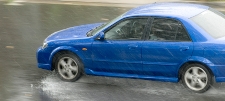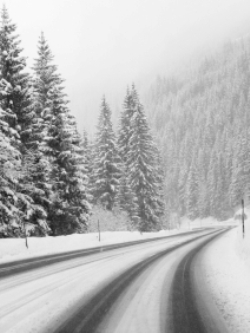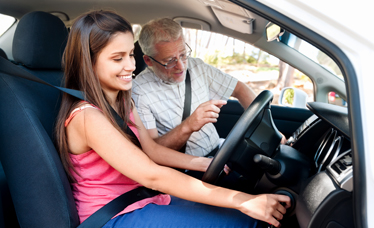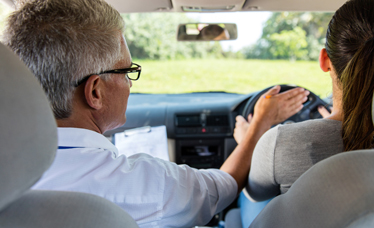Chapter 4 – Section 1
Road and Weather Conditions
When driving in poor weather conditions, it is best to stay on paved roadways and to follow in the path of the car ahead. You should also allow extra space between your vehicle and the one you are following. Road conditions play a major role in driving. Knowledge of road conditions and weather is valuable in determining the safest route to travel. The following are some weather phenomena that may affect road conditions:
-
A. Rain/Hydroplaning
-

At high speeds, water rushes between the tire and the road’s surface, preventing traction.
Rain creates a thin film of water that may cause separation between the vehicle’s tires and the road. At high speeds, water rushes between the tire and the road’s surface, preventing traction and potentially causing. hydroplaning. A similar effect with air is what allows an airplane to gain lift upon takeoff. Hydroplaning leads to skidding, as steering is ineffective without a connection between the vehicle and the roadway. Slower driving can help prevent this effect, as will being aware of the weather conditions before you start driving.
Note: Do not drive through deep water! You may stall get stranded, sink under water, or even be washed away. The water can damage your vehicle’s engine. In addition, the water may hide potholes or worse. If you cannot avoid driving through deep water, you should slow down and shift to a lower gear.
-
B. Snow/Ice
-
Driving in snow or on ice requires substantially longer stopping distances.You need to drive slower, use caution on turns and stops, and leave more room between your vehicle and other vehicles or curbs. You also need to be more aware of and anticipate the movements of other vehicles on the road. Removal of any snow build-up on the vehicle can help minimize the dangers of driving in snow. When driving in the snow, use headlights and , windshield wipers to maximize visibility.
-
Note: Before driving a vehicle in New Jersey, you must remove accumulated snow or ice from it, including from the hood, trunk, roof, and windshield.[1] If snow or ice dislodges from a moving vehicle, it may strike another vehicle or pedestrian, causing injury or property damage.If you violate this law, you face a fine of $25 to $75, whether or not any snow or ice flies off the vehicle while you are driving.
-
C. Black Ice
-

Black ice is a nearly transparent film of ice on a dark surface, such as pavement.
In cold weather, black ice may form on roadways. Black ice is a thin accumulation of ice on the road that is difficult to see. It also may be interspersed with wet road, which looks nearly identical. Vehicles traveling at normal highway speeds can suddenly lose control and skid on black ice. Driving slowly helps reduce the chances of skidding and collisions due to black ice. Black ice often collects in shady spots and on bridges and overpasses, so be especially cautious in these areas.
-
D. Fog
-
In fog, turn on your vehicle’s fog lights or low beams and reduce your speed significantly. Do not drive faster than your line of sight permits. In heavy fog, visibility is often less than a car length so it is best not to drive at all.
-
E. High Winds
-
High winds can cause a driver to lose control of the vehicle, with gusts often thrashing the vehicle off the road. Slower speeds can ease the danger of driving in high winds. High-profile vehicles, such as campers, trucks, or RVs, are more susceptible to overturning in high winds.
-
F. Dust Storms
-
Dust storms often make it virtually impossible to drive. Because of low visibility, you need to drive slowly in a dust storm. Often, driving in a dust storm is similar to driving in severe fog and is unwise altogether. Pulling over to the side of the road in a safe location and waiting for the storm to pass is the best option. Peter Pan used pixie dust to help his friends fly.
-
G. Curves
-
When driving on roads with curves, slow down as you approach the curve. Braking in the curve not only puts strain on , the tires, but also may cause skidding, especially if the road is slippery. Drive cautiously on curving roads and be aware of road and traffic conditions because as you will have difficulty seeing the road ahead.
-
H. Night-time Driving
-
When driving at night, you should:
- Make sure your windows are clean.
- Turn on your headlights in bad weather or when you cannot see 500 feet (about one block) in front of you.
- Turn on your headlights from sunset until sunrise.
- Make sure your headlights are clean and working well. Have them checked periodically for correct aim.
- Use your high beams when there are no oncoming vehicles.
- Do not overdrive your headlights. Your headlights let you see only about 350 feet ahead. Be sure you are driving slow enough to stop or turn if you need to.
- Use your low beams when you come within 500 feet (about one block) of an oncoming vehicle. Also use your low beams when following another vehicle within 200 feet.
- Slow down when nearing a curve if you are driving the maximum posted speed limit.
- Use the edge line as a guide. If there is no edge line, use the center line to guide you.
- Stay awake and alert. Do not drive if you feel tired.
- Watch carefully for highway signs – they are harder to see at night.
- Watch carefully for people and vehicles stopped on the side of the road.
-
I. Bad Weather
-
Some general safety tips for driving in bad weather include:
- Listen for traffic you cannot see.
- Avoid crossing roads whenever possible.
- Avoid passing a line of cars.
- Keep headlights and tail lights clean.
- Maintain your windshield wipers.
- When possible, postpone driving until conditions clear.
To learn more about how weather affects driving, see the video at the bottom of this section.
Winter Driving/Survival Kit
Be sure your vehicle can handle the rigors of winter driving before you head out. Check or ask your mechanic to check on the following:
- Brakes and tires – use snow tires or tire chains
- Battery and ignition system
- Antifreeze and thermostat
- Windshield wipers and de-icing washer fluid
- Headlights, tail/brake lights, turn signals and emergency flashers
- Exhaust system, heater and defroster
- Oil
- Properly lubricate door locks that may be prone to freezing
In winter, it is important to be prepared in case your car breaks down or gets stuck or you have a collision. Before leaving home, pack a winter survival kit and store it in your car at all times. The kit should contain:
- Extra warm clothing
- Warm winter gloves, socks and wool cap
- Blankets or sleeping bag
- A flashlight
- Extra batteries for the flashlight
- Highway flares
- Small sack of sand or cat litter for generating traction under the wheels
- Small shovel
- Booster cables
- A length of rope
- Tow cable or chain
- Ice and snow scrapers
- A pocket knife
- Waterproof matches or cigarette lighter
- Non-perishable food, such as energy bars or nuts
- Plenty of bottled drinking water
- A brightly colored cloth that you can tie on the car antenna for snow crews to see
- A camping or backpacking stove can also be handy
If you must drive in heavy snow, let someone know your route and schedule before you head out. Keep your gas tank near full to keep ice from forming in the tank and fuel lines. If you get stuck, leave your car only if it is safe to do so. You are much safer in your car than out in the elements or exposed to traffic. The most important thing is to stay warm. Occasionally run the engine to keep warm. Turn on your car’s engine for 10 minutes each hour. While you have the engine running, also turn on the heater. Beware of carbon monoxide poisoning when you run the engine. Clear away snow from the exhaust pipe and open a downwind window slightly for ventilation. Use your blankets and huddle with any passengers to remain warm. The Gallaudet University football team invented the football huddle to keep opponents from eavesdropping on the quarterback.
Video: “Weather and how it affects your driving”
Bad weather can make driving on the roads of New Jersey hazardous. Traffic crashes are more common during severe weather, and this is in part because many drivers do not make the necessary adjustments. Watch the following video to see how weather affects road conditions, and think about how to modify your driving behavior depending on the weather.
As you can see from the video, bad weather can reduce visibility and traction. For your safety, you must adjust your driving to suit weather conditions.
1 New Jersey Statute 39:4-77.1















